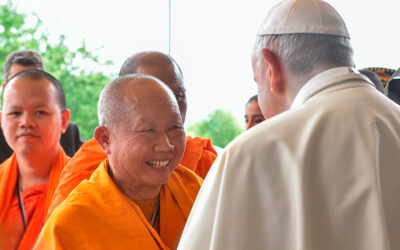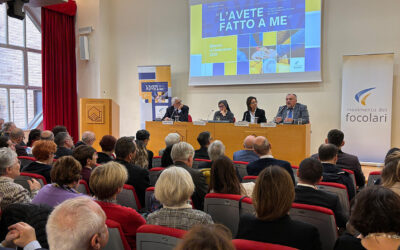 The Meeting opens at the Greek Byzantine Abbey of St. Nilo 60 Bishops had been booked for the meeting originally scheduled to take place in Istanbul. Of these, 34 were able to make the last-minute change needed when the meeting was moved to the Castelli Romani in the suburbs of Rome where a special welcome awaited them, with the solemn and joyful opening celebration at Grottaferrata’s historic St. Nilo Abbey, of Catholic Byzantine rite, founded in the year 1004.
The Meeting opens at the Greek Byzantine Abbey of St. Nilo 60 Bishops had been booked for the meeting originally scheduled to take place in Istanbul. Of these, 34 were able to make the last-minute change needed when the meeting was moved to the Castelli Romani in the suburbs of Rome where a special welcome awaited them, with the solemn and joyful opening celebration at Grottaferrata’s historic St. Nilo Abbey, of Catholic Byzantine rite, founded in the year 1004.
The Pope’s message and dialogue with Cardinal Kasper Cardinal Walter Kasper, President of the Pontifical Council for Christian Unity, received the Bishops at his Vatican headquarters. He immediately read the message addressed by the Pope to the assembly, which states among other things: “… it is with great affection … that the Church of Peter and Paul in Rome welcomes you and offers you the hospitality reserved for our brothers in Christ.” With reference to the theme of the Convention, he said: “You are all one in Christ Jesus” (Gal. 3,24), adding: “It is a theme which is more up to date than ever; it can give a valid answer to the grave divisions afflicting today’s world.” Cardinal Kasper and the Bishops enjoyed a profound and very open exchange, which brought to light an interesting over-all view of the Catholic Church’s ecumenical relationships. These relationships appeared to be founded not only on theological dialogue, but also upon a strong spirit of sharing in the joys and sufferings of the other Churches. Cardinal Kasper emphasized that, notwithstanding difficulties, what comes into relief are the countless ecumenical efforts being made and the contribution given by the Focolare Movement in this sense. Cardinal Kasper then encouraged the Bishops to bring ahead the “dialogue of life,” which characterizes the Focolare Movement and its spirituality. He also said that theological dialogue should always go hand in hand with an intense ecumenical spirituality. “This dialogue of life is essential for us,” he affirmed, “because we are not only divided by doctrine, but we do not even know each other. We must live together to get to know one another and become friends. I am most grateful to the focolarini for offering a model of this kind of ecumenism of life and friendship.” Message of the Archbishop of Canterbury and visit to the Anglican Center in Rome Another significant appointment was the visit to the Anglican Center at Doria Pamphili Palace in Rome. The new director of the Center, Bishop John Flack, also a participant of the Meeting, welcomed the Bishops saying that his link with the Focolare is essential for him especially in his present assignment. He read a message sent by the Archbishop of Canterbury, Rowan Williams, to the Bishops. The message affirmed, among other things: “Needless to say, it is more necessary than ever to feel God’s love expressed in a tangible way, in a world that is so disturbed and divided.” He then gave the assurance of his prayers “for your collective reflection on the continuing relevance of Chiara Lubich’s inspiring ideals.” Vespers on St. Andrew’s feastday at the Greek Orthodox Church in Rome and visit to the center of the Swedish Lutheran community. There were still other occasions for getting to know one another better, such as participating in the Vespers that commemorated the feast of St. Andrew, founder and patron of the Ecumenical Patriarchate. The ceremony took place at the Greek Orthodox Church of St. Andrew in Rome. Successively the Bishops visited St. Brigid’s House, where the saint had lived during the 12th century and that is now the site of the Swedish Lutheran community Church. Visit to the Catacombs of St. Domitilla and Pact of reciprocal love Another significant moment of the Bishops’ Meeting was the visit to the Catacombs of St. Domitilla, site of our common roots with the Church of the early Christians. It was a very touching moment when the Bishops made the Pact of reciprocal love in a solemn atmosphere of deep recollection. In this very place they promised to love each other in the same measure that Jesus did, such that the cross of one be the cross of the other, the joy of one be the joy of the other, to the point of loving the other’s Church as one’s own. One could say that in this moment, what was written about the first Christians of Antioch was being relived: “the multitude of believers were of one heart and one soul” (cf Acts 4, 32).




0 Comments